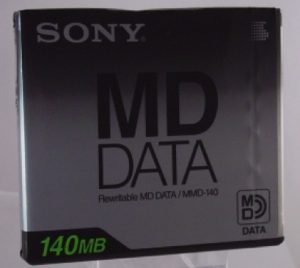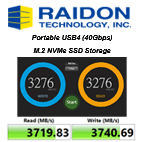History (1994): MiniDisc Data by Sony
Magneto-optical disc format based on same technology as audio MiniDisc
This is a Press Release edited by StorageNewsletter.com on November 8, 2018 at 2:21 pmThis article was published by the Museum of Obsolete Media.
MD Data (1994-early 2000s)

MD Data (which stood for ‘MiniDisc Data’) was a magneto-optical disc format, introduced by Sony in 1994 and based on the same technology as the audio MiniDisc launched in 1992.
Like the MiniDisc, MD Da-ta consisted of a small 65mm diameter rigid disk enclosed in a caddy with a shutter, and was recordable. Although MD Data disc caddies have the same dimensions as MiniDisc (7×6.75×0.5 cm), the caddies have some differences to MiniDiscs such as a different shutter shape, and most MD Data drives could not write to audio MiniDiscs.
Some MD Data devices could play the audio from MiniDiscs via the audio-out jack, and some multi-track recorders could record to audio MiniDiscs, but only in 2-track mode.
As with other types of magneto-optical discs, there is a layer of ferromagnetic material sealed in the disc. To record data, a laser on one side of the disc heats a spot to its Curie point. A magnetic head on the opposing side of the disc can then alter the polarity of the heated spot. When played back, the laser detects the polarisation of the reflected light. Sony claimed that discs can be recorded on repeatedly, up to one million times, and unlike other magneto-optical discs, MD Data disks were rewritten in a single pass.
MD Data discs provided 140MB of data storage, which for the time was a significant amount for a removable data storage format (for instance, Iomega’s 100MB Zip Drive was not launched until 1995).
However, MD Data was regarded as slow (one user reported it as feeling like a single speed CD-ROM drive) and expensive (with discs around $25 in 1995), and although there was an internal and an external MD Data drive available for computers, it never took off as a computer storage format. This was despite a Sony spokesperson proclaiming on its launch “We think it’s the floppy disk of the future.“
Their main use was in a handful of Sony still digital cameras, a Sharp digital camera, Sony document scanners, Sony still video recorders (for medical use during investigative procedures or surgery) and some multi-track audio recording decks from Sony, Yamaha and Tascam.
In 1997, Sony announced the MD Data2 format (also known as MD View), which could hold 650MB of data but this was only used in a Sony camcorder (the DCM-M1 or MD Discam) introduced in 1999, and even at the time the discs were reportedly difficult to source. Existing MD Data devices could not use the newer MD Data2 discs.
The last product to use MD Data was introduced in 1997, and by 2004 Sony had introduced the Hi-MD format (which was discontinued in 2011) that had a capacity of 1GB and was compatible with audio MiniDiscs. MiniDiscs themselves lasted until 2013 when the last players were sold.














 Subscribe to our free daily newsletter
Subscribe to our free daily newsletter


